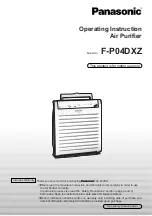
INDICATIONS OF PROPER SYSTEM OPERATION
Cooling
Cooling operation is the same as any conventional air condi-
tioning unit.
1. The outdoor fan should be running, with warm air being
discharged from the top of the unit.
2. The indoor blower will be operating, discharging cool air
from the ducts.
3. The vapor line at the outdoor unit will feel cool to the touch.
4. The liquid line at the outdoor unit will feel warm to the touch.
Heating
Indications of proper heating operation is as follows:
1. The outdoor fan should be running, with cool air being
discharged from the top of the unit.
2. The indoor blower will be operating, discharging warm air
from the ducts.
3. The vapor line at the outdoor unit will feel warm to the touch.
4. The liquid line at the outdoor unit will feel cool to the touch.
The system can operate either as a heat pump with electric or
add-on hot water hydronic heat, or as a heat pump with furnace
back up heat.
HEAT / COOL TRIATHLON OPERATION
Basic System Operation
COOLING MODE:
•
The thermostat will initiate a demand for system operation.
Light on the thermostat will light indicating demand.
•
The reversing valve will be energized.
•
The outdoor fan will start, then the engine will start at 1,500
rpm.
•
The indoor fan will start after a delay.
•
Coolant will recirculate through the engine until tempera-
tures are adequate to open the coolant thermostat and send
coolant to the outdoor coil.
HEATING MODE:
The system will operate as a heat pump or as a furnace in
heating.
The operation of the heat pump and the furnace will be covered
separately. The flowchart (see Figure 15) shows the control
sequence.
Heat Pump
•
The thermostat will call for system operation. The light on
the thermostat will light, indicating demand.
•
The outdoor fan will start, then the engine will start at 1,500
rpm.
•
The indoor fan will start after a delay.
•
Coolant will recirculate through the engine until tempera-
tures are adequate to open the coolant thermostat and send
coolant to the outdoor coil.
•
Engine speed will adjust after initial startup based on the
demand from the thermostat.
•
It is possible for the indoor blower to be operating if the
thermostat fan switch is set for continuous fan.
Furnace
Furnace operation is the normal heating mode when one of the
following is present:
•
There is a call for 3rd stage heat or emergency heat ("W"
signal sent from thermostat)
•
The outdoor temperature is less than 43
°
F.
•
The refrigerant liquid temperature is less than 35
°
F.
If any of these conditions is present the heat pump system will
shut down and the furnace will be engaged to provide all heat
required. The heat pump will not attempt a restart until a heating
cycle has been completed and the following conditions are met:
•
There is no call for 3rd stage heat or emergency heat (no
"W" signal being sent by the thermostat).
•
The outdoor temperature is greater than 46
°
F.
The refrigerant liquid temperature is greater then 38
°
F.
•
The thermostat will call for system operation. The light on
the thermostat will light, indicating demand.There is a six
minute off-time between cooling or heating cycles. If the
system has cycled off it will be a minimum of six minutes
before it will be allowed to restart.
•
The gas valve is energized after a pre-purge by the inducer
motor and after the ignitor has warmed has warmed up.
•
Ignition occurs in the furnace and the heat exchanger begins
heating
•
The indoor (furnace blower) fan will start after a delay.
•
It is possible for the indoor blower to be operating if the
thermostat fan switch is set for continuous fan.
TECHNICAL OPERATION
Cooling Mode
1. The thermostat calls for cooling. There is a six minute
off-time between cooling or heating cycles. If the system
has cycled off it will be a minimum of six minutes before it
will be allowed to restart.
2. The reversing valve toggles to relieve pressure differential
and then energizes.
3. The unit control will self-test, then perform a system check
to determine if sensors are correctly opened / closed.
4. An engine start is attempted. If start is successful, the
engine comes up to 1500 rpm. If the start is unsuccessful,
another start will be attempted. The engine will attempt 5
starts before a fault requiring a shut-down occurs. A fault
will be posted and a six minute delay will occur until another
five attempt cycle can be made. After three sets of failed
start attempts (15 actual start attempts) the system will
shut down, post a fault and lock out.
5. After a successful start, the indoor unit blower will start at
minimum speed. It is possible for the indoor blower to
already be operating if the thermostat fan switch is set to
continuous fan.
6. After the engine speed reaches adequate operating tem-
perature, the system will respond to thermostat commands
and speed up or slow down as required. Maximum cooling
is achieved when the engine speed reaches 3000 rpm.
515.35-N6Y
10
Unitary Products Group
Содержание E3GE036S01B
Страница 20: ...WIRING DIAGRAMS 515 35 N6Y 20 Unitary Products Group ...
Страница 21: ...515 35 N6Y Unitary Products Group 21 ...
Страница 22: ...NOTES 515 35 N6Y 22 Unitary Products Group ...
Страница 23: ...NOTES 515 35 N6Y Unitary Products Group 23 ...










































